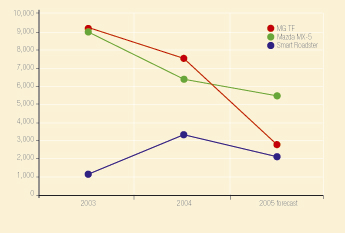No-one embodied this approach more than Daimler, who bought, or merged with (depending on the legal submission you refer to) Chrysler and Mitsubishi to provide a global footprint.
Of course, some morsels proved indigestible: BMW regurgitated Rover and DaimlerChrysler did the same to Mitsubishi. But what about brands, or even models, that prove to be unwanted?
The news that Daimler-Chrysler has been approached by up to six bidders to take over the axed Smart Roadster is intriguing. In theory, the roadster should be able to survive: it is cute, fashionable and reasonably in demand, at least in the UK. Stripped of its DaimlerChrysler overheads, could it be a profitable little niche car for someone?
The idea of car companies disposing of problem children opens up other possibilities. Traditionally, companies that have been bought outright are usually closed down if things don’t work out (think of most of the constituent parts of British Leyland), but brands are now too valuable to abandon – even Fiat is now planning to recreate Lancia.
There are persistent rumours that Ford has had informal discussions with other manufacturers about a sale of Jaguar, although it is now said to be staying put.
Nevertheless, the change in the economics of car manufacturing makes transferring models more feasible than it once was. A model that is in production can always be found a new production home: that task is a lot easier than developing a new model from scratch.
The fact that carmakers use sub-contractors to build a proportion of their models (some Porsches come from Valmet in Finland and many Chryslers are assembled by Magna Steyr in Austria) shows that production can be shuffled around when required.
Now that new brands are very difficult to create and there are few independent ones to buy, could we be entering a new era when car manufacturers trade brands between themselves? Less profitable groups with a plethora of brands might be tempted to sell to a cash-rich corporation with few brands.
Alternatively, there seems to be a lot of venture-capital money available for would-be car manufacturers at present.
When Nikolai Smolensky bought TVR, he pipped a well-funded venture capital consortium. When MG Rover collapsed, the administrators could have sold the MG TF many times over, but they wanted to sell the whole concern, which was a pretty effective poison pill to most potential buyers.
Car companies being sold outside the traditional car industry to outsiders who cherry pick brands, expertise and technology? That would be a major change to the way the business operates.
Roadster sales 2003-2005

As the MG TF has been axed and Mazda is changing over to a new model, with a relaunch, the Smart could expect annual sales of 3,000 in the UK. One of Britain’s most enduring sports cars, the Caterham 7, only came about when Lotus pulled out of the market for affordable sports cars. One of their dealers bought the rights to the obsolete Lotus 7. Could the Roadster achieve similar success?












Login to comment
Comments
No comments have been made yet.